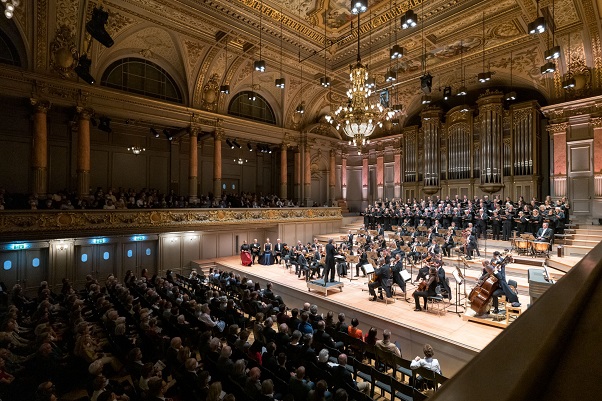 Switzerland Verdi, Messa da Requiem: Der Gemischte Chor Zürich, Margarita Vilsone (soprano), Deirdre Angenent (mezzo soprano), Jason Kim (tenor), Tobias Schabel (bass), Tonhalle Orchester Zürich / Joachim Krause (conductor). Tonhalle, Zurich, 6.4.2023. (VL)
Switzerland Verdi, Messa da Requiem: Der Gemischte Chor Zürich, Margarita Vilsone (soprano), Deirdre Angenent (mezzo soprano), Jason Kim (tenor), Tobias Schabel (bass), Tonhalle Orchester Zürich / Joachim Krause (conductor). Tonhalle, Zurich, 6.4.2023. (VL)

Another memorable performance by the Gemischter Chor was heard on Maundy Thursday and Good Friday at the Tonhalle Zurich. The Gemischter Chor is one of the founding choirs of the Tonhalle Zurich and has been in existence since 1863. The choir singers are amateurs with trained voices who enjoy singing; 100 to 120 singers generally participate in their concerts. The choir was accompanied by the Tonhalle-Orchester Zürich.
Verdi wrote the final movement of his Messa da Requiem, ‘Libera me’, as early as in 1868/69. It was intended for a funeral mass for the late Gioachino Rossini, the Messa per Rossini, which he and other composers were to perform on the occasion of first anniversary of Rossini’s death: however, the work was not performed as planned and fell into oblivion. Verdi used the final movement years later for a funeral mass in honour of Alessandro Manzoni, the ‘Libera me’ forming the final part of the work, almost unchanged, but serving as the nucleus of the entire Requiem. Thus, Messa da Requiem was premiered as planned on the first anniversary of Manzoni’s death, on 22 May 1874 in the church of San Marco in Milan.
There could hardly be a better work to mark the most important of the Christian holidays than Verdi’s Messa da Requiem. The text and the structure of the work correspond almost entirely to the Roman Catholic liturgy of the mass for the dead. But the score is for an opera orchestra with four soloists and choir.
The choir gently introduces the initial bars of the first movement – the Requiem. In terms of content, the first movement is partly reminiscent of an intercession – performed by the choir and soloists. The strings accompany the choir at the beginning, but then fall silent and leave the stage entirely to the choir. After a few gentle a cappella bars, the orchestra comes back in and accompanies the choir with appropriate restraint. Already in this first movement, the listener gets the feeling of being in a Catholic church service – the proximity to the liturgy for the dead is unmistakable. The soloists then begin. Particularly touching and convincing was soprano Margarita Vilsone, her voice and facial expressions embodying the infinite suffering that Verdi wished to convey. The first movement ends with the well-known ‘Kyrie eleison’, with which church services usually begin.
In sharp contrast to the first movement is the second movement, ‘Dies irae’, a musical illustration of Judgement Day. This second sequence is divided into nine parts, in which the choir and the four soloists are used in alternating, different constellations. It is particularly striking that the first part of the second sequence begins imposingly with choir and orchestral accompaniment, perfectly underlining the action of the second movement. Another highlight in the second movement for me was Tobias Schabel’s solo in the seventh part.
In contrast to the fourth movement, the third movement begins very softly and is sung exclusively by the soloists. In the fourth movement, the imposing ‘Sanctus’, only the choir is heard, singing in four voices, and as a double choir to boot – truly worthy of the Hosanna in excelsis.
In the two following movements, soloists and choir were again heard in alternation – in a memorable a cappella as well as with the accompaniment of the orchestra.
The undoubted highlight – the finale of the liturgy – was, of course, the final movement, ‘Libera me’ – originally dedicated to Rossini, then slightly modified for Manzoni, leading up to its present version. The theme of the second movement is repeated and the first movement is also taken up again, so that the ‘Libera me’ forms a perfect conclusion to the Messa da Requiem.
The conductor’s baton is lowered, soloists and choir give the audience a relieved smile, they seem to know that it was a truly successful performance. And the audience proves them right. Standing ovations applaud the beautiful performance on this Maundy Thursday. The four soloists Margarita Vilsone (soprano), Deirdre Angenent, (mezzo-soprano), Jason Kim (tenor) and Tobias Schabel (bass) complemented the choir wonderfully and demonstrated their skills impressively.
While the soloists and the orchestra received thunderous applause, the audience managed to increase it even more when the choir finally rose to collect their well-deserved laurels. Rightly so – once again, the Gemischte Chor gave a fantastic performance.
The Gemischte Chor performs twice a year at the Tonhalle, and I can only encourage any and all concert enthusiasts to attend their concerts. I am already looking forward to the next one.
Valérie Litz
